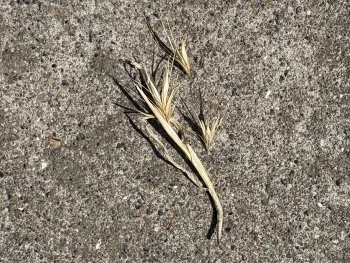
Weeds are a perennial problem for gardeners. One of the most feared weeds for pet owners is the “foxtail”.
The “foxtail” is the seed from a variety of different grassy weeds, and the seed has barbed awns (stiff bristles) with a sharp point that goes in easily and barbs that prevent the seed from backing out. These spread quickly and easily due to prolific seed production.
The foxtail seed is easy to go in and hard to get out, potentially causing serious injury to animals, including dogs.
Management strategies depend on the grass species, especially in the case of large infestations, including parks, semi-wild areas, walking and bicycle paths and parks, including dog parks.
What are foxtails?
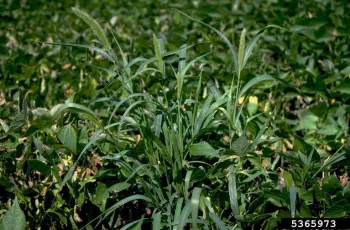
Foxtails include annual barleys and bromes (a common type of grass) going to seed. Foxtail is a name that applies to many species. A blog written by Rebecca Ozeran, Livestock & Natural Resources Advisor, UCCE, lists some grasses that are commonly called “foxtails” (or their seeds are) in Fresno and Madera Counties.
If you look up the name “foxtail”, you will find it associated with a grass species (Setaria spp), actually named “foxtail”, but these grasses are not usually associated with animal injuries. (See photo at right.)
It may seem that it doesn’t matter what plant produced the “foxtail” that might harm your dog or wildlife. But if there is a large infestation, it is important to know what species you are concerned with since each has its own strengths and weaknesses that affect the managing of these weeds.
What are some common species that are called “foxtails”?
Here are some of the species that have barbed awns. This particular list is from a blog article, “The Many Faces of Foxtails” (2021) by Rebecca Ozeran, UCCE Livestock & Natural Resources Advisor. This is definitely not a comprehensive list, but gives one an idea of the wide number of plants that have barbed awns.
The scientific names in the table below will help you find more information on identification and management of these species. As you can see in the table, most of these "foxtail" are winter annuals, meaning that they germinate in the fall and winter and grow actively in the spring. After they flower and go to seed, they die, and they will reappear again as new seeds grow. Of this list, only Foxtail Barley (Hordeum jubatum) is a perennial, and it also is the only one that is native to the western U.S. The other six plants are considered to be invasive plants by The California Invasive Plant Council (Cal-IPC) with either severe or moderate ecological impacts.
Official Common Name | Scientific Name | Growth Cycle Information and Links to Photos and More Specific Plant Details and Management
| California Invasive Plant Council (Cal-IPC) rating* |
Hare or Mouse barley 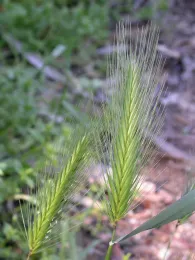 | Hordeum murinum | Winter annual https://www.cal-ipc.org/plants/profile/horderum-murinum-profile/
| Moderate |
Mediterranean barley 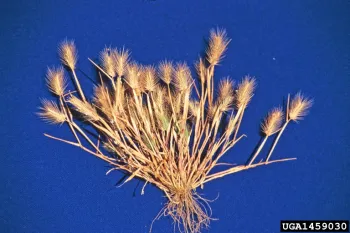
| Hordeum marinum | Winter annual https://www.cal-ipc.org/plants/profile/hordeum-marinum-profile/ | Moderate |
Foxtail barley 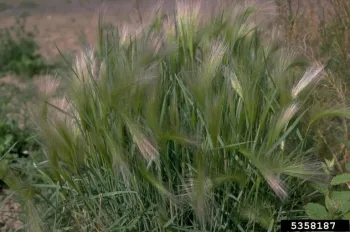 | Hordeum jubatum | Short-lived, cool-season perennial native to western U.S. including California | Not ranked or listed since it is a native plant |
Red or Foxtail brome 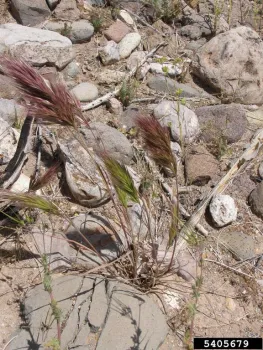 | Bromus madritensis | Winter annual. Most seeds germinate the following fall after the first significant rain. https://www.cal-ipc.org/resources/library/publications/ipcw/report20/ https://www.calflora.org/app/taxon?crn=1209
| High |
Cheatgrass or Downy brome 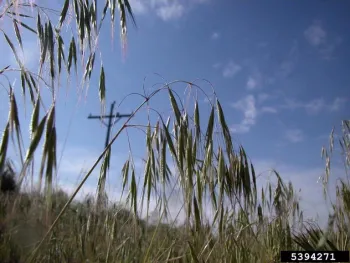 | Bromus tectorum | Winter annual. Most seeds germinate the following fall after the first significant rain. most widespread of the bromes. https://www.cal-ipc.org/wp-content/uploads/2019/09/Bromus_tectorum_Cal-IPC.pdf | High |
Ripgut brome 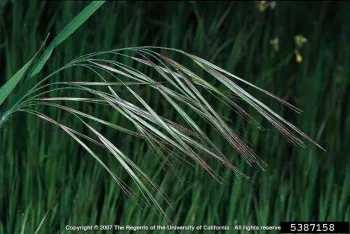 | Bromus diandrus | Winter annual. Most seeds germinate the following fall after the first significant rain. | Moderate |
Medusahead rye 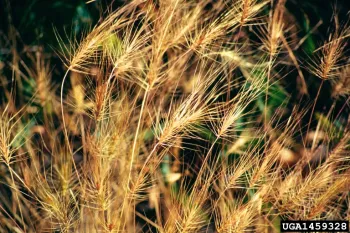 | Taeniatherum caput-medusae or aka Elymus caput-medusae | Winter Annual, sprouts in fall but goes to seed later than other annuals https://www.cal-ipc.org/plants/profile/taeniatherum-caput-medusae-profile/ https://www.cal-ipc.org/wp-content/uploads/2019/09/Elymus_caput-medusae_Cal-IPC.pdf | High |
*The California Invasive Plant Council (Cal-IPC)
High – These species have severe ecological impacts on physical processes, plant and animal communities, and vegetation structure. Their reproductive biology and other attributes are conducive to moderate to high rates of dispersal and establishment. Most are widely distributed ecologically.
Moderate – These species have substantial and apparent-but generally not severe-ecological impacts on physical processes, plant and animal communities, and vegetation structure. Their reproductive biology and other attributes are conducive to moderate to high rates of dispersal, though establishment is generally dependent upon ecological disturbance. Ecological amplitude and distribution may range from limited to widespread.
How to control small infestations of “foxtails” in the garden.
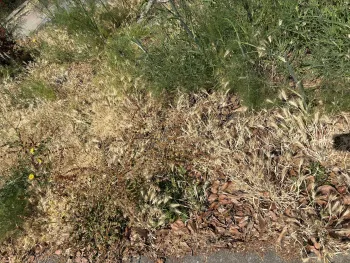
These plants are generally “winter annuals” and they begin to grow and sprout after the first significant rains. Here are some steps to manage barley, brome and rye “foxtails” by handweeding at the right time in small infestations.
- Remove when young, roots and all, in fall and winter
- Get them before they release seeds in late spring and summer.
- If they go to seed, remove as much of the seeds as possible
- Minimize soil disturbance (turning the soil)
- Mulch where you weeded. Mulch deeply , at 3-4 inches deep
- Quickly cover bare patches with new plantings and choke out weeds
- If using chemical herbicides, identify the weed first and then check product labels to see which herbicides are most effective.
How to mechanically control barley and brome “foxtail” in larger landscapes
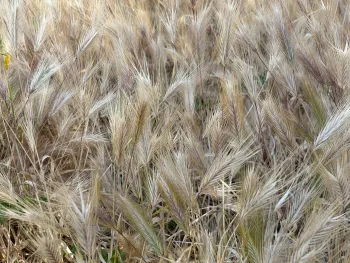
This information on mechanical control is from excerpts from the book Weed Control in Natural Areas in the Western United States. Links from the UC Weed Research and Information Center are provided below for more management information on these barley, brome and rye species.
Helpful hints here for hand weeding tools and techniques: Best Managment Practices for Non-Chemical Weed Control. (PDF)
Hare Barley and Mediterranean barley
- Small infestations can be removed by digging and hand-pulling.
- Pull the entire plant, roots and all, before spike formation.
- Mowing can somewhat suppress Mediterranean and hare barley. The weed typically recovers if mowed before maturity and senescence. However, fewer seedheads are produced when the plant regrows.
- Mowing and removing the plant clippings can reduce germination the following year.
- Digging and turning the soil are effective at controlling emerged plants but can stimulate subsequent emergence.
Foxtail barley (PDF)
- Fairly tolerant of cutting or mowing. Mowing can help interrupt seed production, but the plants recover, often grow more prostrate (stems lying flat along the ground), and continue to flower.
- This native species usually can be controlled by plowing (turning soil over, burying weeds and others organic matter to depth of 8 inches or more) in fall followed by cultivation such as harrowing (breaking up clods and leveling the soil surface) in spring. However, spring tillage (digging and turning the soil) alone is significantly less effective.
The bromes (PDF) (Red or Foxtail brome, Cheatgrass or Downy brome, Ripgut brome)
- Hand pulling or hoed in early spring before seeds are ripe.
- Repeated mowing (every 3 weeks) can reduce seed production but is not usually recommended.
- Shallow cultivation (turning the soil to depth of 2-4 inches) shortly after the main flush of germination and again a little later can eliminate most seedlings.
Medusahead (PDF)
- There are mixed reports on the effectiveness of mowing.
- Early-season mowing is likely to be ineffective and may harm other species.
- Late-season mowing, at the boot stage (just about to produce a seedhead) to early flowering stage, may help to suppress medusahead. However, mowing after seed set will disperse the seeds
More information on mechanical and chemical controls are available from Weed Research and Information Center (WRIC). See the California Invasive Plant Council (Cal-IPC) Inventory / as well as their plant profiles for photos, descriptions, weed management and more.
UC IPM WeedCUT This decision support tool provides land managers with guidance on a range of methods for managing invasive plants in wildlands using non-chemical approaches ...
For help with weed identification:
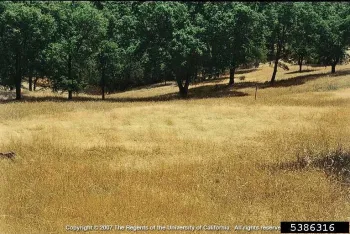
Identification is extremely important in the management of weeds, especially for large infestations of weeds.
Here are an UCANR video on digital tools for weed identification and management by Rebecca Ozeran, UCCE Livestock & Natural Resources Advisor. It is is a useful resource on how to use Weed ID tools including Plant ID apps.
Another starting point in identifying weeds might be to use photos to narrow down choices. Once identified, information about the plant will help the understanding of the life cycle of the plant and choosing the most appropriate control measures.
The following are some photo resources:
UC IPM Weed Gallery -- Grass Gallery List of Grasses with links to more information UC IPM Weed Gallery
The California Invasive Plant Council (Cal-IPC) Inventory
Cal-IPC plant profiles for photos, descriptions, weed management and more.
Field Guide for Common California Rangeland and Pasture Plants (PDF)
Wildflower Search This website helps those of us with limited knowledge of botany to identify plants that are found outside of gardens. This help is provided by presenting you with small images of plants.
Want to learn more?
This blog post is brought to you by the Help Desk of the UC Master Gardeners of Alameda County. Subscribe to our blog!
Have a gardening question? We'll help.
Visit our Help Desk page to submit your question and see additional ways you can reach us.

